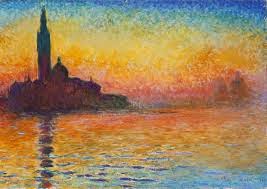If you seek a spectacular sunset reenacted on
canvas you shouldn’t miss Venice at Dusk or San Giorgio Maggiore
al Crepuscolo painted by French Impressionist Claude Monet. The work was
finished in 1908 with 37 others in the ancient city of Venice Italy. Monet did not feel that his paintings were
that great and had significant self-doubt about is work but they nevertheless
became well known.
He wrote to an art seller about that doubt ,"Although I am enthusiastic
about Venice, and though I've started a few canvases, I'm afraid I will only
bring back beginnings that will be nothing else but souvenirs for me"
(1).
Despite his yearnings to quit Monet continued to
paint each and every day completing a number of great masterpieces. His works
are known for their simplicity and eloquence that many other painters seem to
forget in forging their works.
The painting is of a sunset behind San Giorgio
Maggiore the sanctuary and monastery (2). Colors
are vibrant yet soft while the brush strokes are thin and small to give it a
slightly distorted view that coincides with early morning light. The
brushstrokes also contribute to the choppy water impression that reflects the monastery
in an imperfect manner.
Claude Monet was one of the main characters behind
the French Impressionist movement. Impressionism is the way in which the eye
first sees an impression and then adds additional detail upon inspection (3). It is
like being blind and then seeing. The goal is to catch a reality or a mood on
canvas form.
Each viewer makes their own interpretation and
impression of the painting. Monet
obviously had a mood and perception which he painted onto canvass. Yet each
of us brings our own mood and perception to understanding that meshes with the
authors to create unique experiences. Art is always in the eye of the beholder.

No comments:
Post a Comment